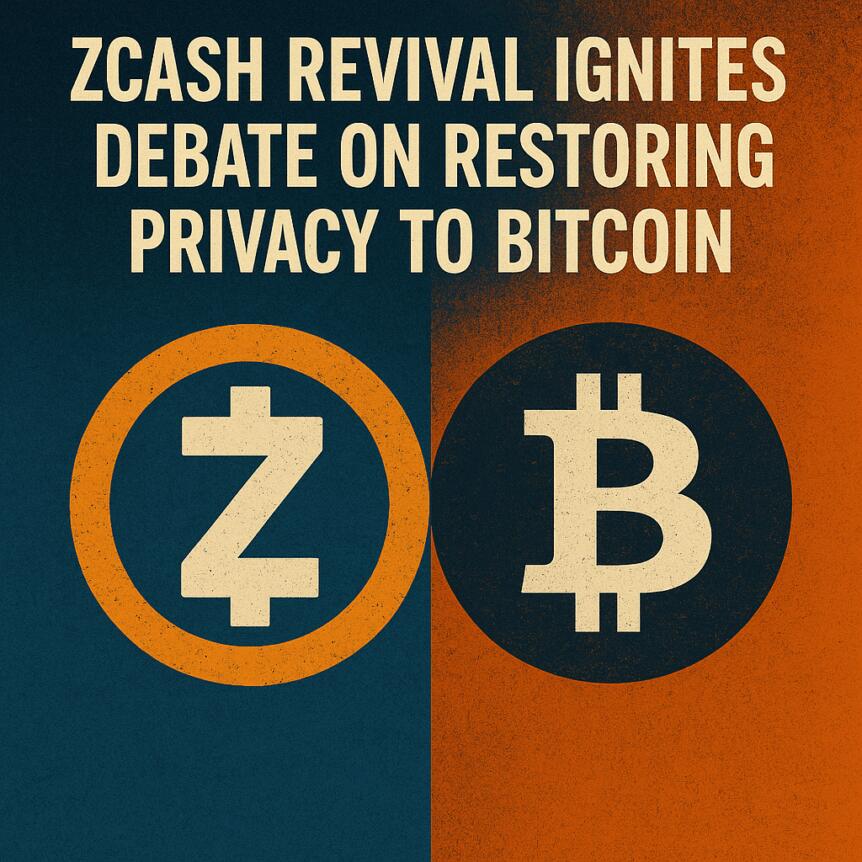Zcash Revival Ignites Debate on Restoring Privacy to Bitcoin

The ongoing debate over privacy in the cryptocurrency ecosystem continues to gain momentum, with influential voices advocating for the adoption of privacy-enhancing protocols like Zcash. As regulatory scrutiny intensifies worldwide, the push for robust privacy features could prompt significant changes within the Bitcoin network, potentially revitalizing discussions around revisiting legacy features such as OP_CAT. Industry leaders and developers alike see these developments as pivotal for shaping the future landscape of crypto privacy and adoption.
- Major crypto figures are rallying behind Zcash, emphasizing its potential to bolster privacy within the crypto ecosystem amid growing regulatory challenges.
- Founder of StarkWare, Eli Ben-Sasson, highlights how zero-knowledge proofs (ZK-proofs) could address Bitcoin’s privacy and scalability issues—if certain legacy opcodes are re-enabled.
- The potential revival of OP_CAT, a disabled Bitcoin opcode, could enable native privacy solutions, aligning Bitcoin more closely with privacy-focused cryptocurrencies like Zcash.
- Industry insiders suggest that Zcash’s resurgence in 2025 might serve as a catalyst for broader privacy enhancements in Bitcoin through soft forks and protocol upgrades.
- Despite the excitement, mainstream Bitcoin developers have yet to actively pursue privacy upgrades, though some prominent figures remain optimistic about potential changes.
Privacy Advocates Push for Zcash Adoption
The crypto community on X is increasingly vocal about adopting Zcash (ZEC), a privacy-centric cryptocurrency lauded for its advanced zero-knowledge proof technology. Influential figures such as the Winklevoss twins, Naval Ravikant, and Balaji Srinivasan view Zcash as a gateway to greater privacy within the broader crypto space. Their advocacy comes amid rising concerns over governmental and regulatory moves that threaten user anonymity and transaction confidentiality.
Origins of Zero-Knowledge Proofs and Zcash
In 2014, Eli Ben-Sasson, a pioneer in zero-knowledge proofs, co-authored the white paper “Zerocash: Decentralized Anonymous Payments from Bitcoin,” which laid the groundwork for Zcash. The work was the culmination of years of research into general-purpose zero-knowledge proof technology, a method capable of assuring transaction validity without revealing sensitive details.
Ben-Sasson explains that these proofs can solve core issues like privacy and scalability while maintaining integrity, even when users aren’t observing transactions directly.
Bitcoin’s Privacy Challenges and Opportunities
While Bitcoin’s transparent ledger has been fundamental to its security and trustworthiness, it also presents privacy limitations. Ben-Sasson notes that with the reactivation of certain legacy features, such as OP_CAT—a Satoshi-era opcode disabled in 2010—Bitcoin could integrate native privacy solutions without the need for sidechains or second-layer protocols.
“We knew zero-knowledge proofs solve two problems: scalability and privacy. They offer integrity,” Ben-Sasson states. “But Bitcoin’s original code doesn’t currently support these capabilities due to past design decisions.”
This presents an intriguing possibility: a simple soft fork to reinstate OP_CAT could enable Bitcoin to integrate ZK-proofs, offering privacy and scalability improvements without overhauling its core architecture.
The Path Forward for Bitcoin Privacy
Ben-Sasson advocates for more openness within the Bitcoin community toward implementing these developments. He argues that the necessary code—comprising only nine lines, including the reactivation of OP_CAT—was originally introduced by Satoshi Nakamoto and could be reinstated with consensus.
Despite the technical feasibility, mainstream Bitcoin developers remain cautious, with limited public discussion about privacy enhancements. Meanwhile, industry veterans like the Winklevoss twins are exploring how Zcash could complement Bitcoin’s core.
The twins established Cypherpunk Technologies, a ZEC-backed treasury company, after acquiring and rebranding Nasdaq-listed Leap Therapeutics, signaling their confidence in privacy-focused projects. As regulatory landscapes tighten, these developments underscore the ongoing push for more privacy solutions in the crypto market, especially for Bitcoin, the industry’s flagship asset.
For more insights on privacy in crypto, it’s clear that the conversation around integrating cutting-edge ZK technology remains critical — promising a future where privacy and transparency coexist more securely on blockchain networks.
This article was originally published as Zcash Revival Ignites Debate on Restoring Privacy to Bitcoin on Crypto Breaking News – your trusted source for crypto news, Bitcoin news, and blockchain updates.
You May Also Like

Prediction markets, DATs, the fee switch, and Project Crypto

Zero Knowledge Proof Whitelist Open: How to Master The 24-Hour ICA Daily Token Distribution

